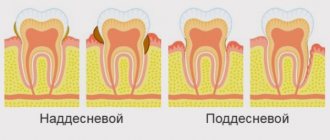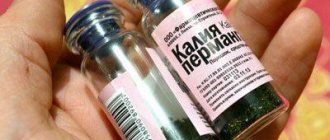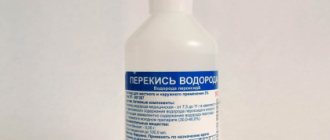Antibacterial compounds play an important role in maintaining oral hygiene. They are necessary to destroy bacteria and reduce pain. A solution of soda, salt and iodine is by far the safest and most affordable means of preventing many dental diseases. Rinsing helps to cope with aching, acute pain, and in some cases even relieve swelling near the gum pocket.
Sodium bicarbonate has many positive properties. Its use prevents the development of carious manifestations and inhibits pathological processes. You can even remove tartar using baking soda powder. Quite often they rinse their mouth with soda after resection of an element of the dentition has been performed or nerve endings have been painfully removed. Antibacterial compounds accelerate the regeneration of soft tissues and have a disinfecting effect.
Treatment of gums with salt
Causes of gum inflammation
Why salt helps
How to properly rinse your mouth with saline solution
Salt gum massage
Other methods for treating gums at home
Bleeding gums, increased sensitivity and bad breath indicate that your gums are not healthy. Why do they become inflamed? Is it necessary to see a doctor or can they be strengthened at home? How to use salt to relieve inflammation? Read more in the article.
Rinse during pregnancy
The expectant mother's body is quite vulnerable to various types of infections. Some immunosuppression occurs to ensure that the fetus has the opportunity to develop normally in the mother's body. However, recently there has been evidence that during the gravidar period, some parts of the immune system, on the contrary, are strengthened. There is an “Immunological paradox” of pregnancy. In response to the action of endotoxins from various bacteria, a woman’s body releases a large number of pro-inflammatory cytokines (a class of substances involved in the implementation of the most important physiological reactions of the body).
Based on this, we can conclude that the specific immune response is suppressed, and the nonspecific, on the contrary, is enhanced.
If you feel a sore throat, you should immediately seek medical help. The doctor will be able to choose effective, and most importantly safe, treatment.
Gargling during pregnancy will not harm2. The liquid promotes mechanical cleansing of the tonsils from dead cells, bacteria, and pus. But remember that rinsing is only part of the therapy. Comprehensive and complete treatment should be prescribed by a doctor, because the expectant mother must take care not only of her health, but also of the condition of her child.
Note!
If the condition remains unchanged during the day or the sore throat intensifies, you should consult a specialist.
Up to contents
Causes of gum inflammation
Gum inflammation can occur for various reasons. Heredity, poor environment, bad habits, hormonal imbalance, etc. But most often, the inflammatory process in the gums occurs due to poor oral hygiene. The more plaque and soft deposits on the teeth, the higher the risk of inflammation. To prevent diseases of teeth and gums, professional hygiene is recommended, which must be done every six months (more often if necessary). The procedure removes deposits that the toothbrush did not reach, freshens breath and makes teeth noticeably whiter.
By the way, scientists conducted an interesting experiment. People who maintained good hygiene and had no dental problems stopped brushing their teeth within three weeks. The result showed that this time is quite enough for primary inflammation to appear on the gums.
Is it possible to gargle with salt?
Rinse is used for sore throat, runny nose, otitis, various pathologies of the ENT organs: acute and chronic tonsillitis, purulent processes in the tonsils, pharyngitis.
At certain concentrations, the salt solution has different therapeutic effects.
Hypertonic dilution of sodium chloride (osmotic pressure is greater than that in the tissues) relieves swelling, reducing sore throat, has antimicrobial activity, thins thick mucus, pus, and helps restore the draining function of the tonsils.
A saline solution with a salt concentration of 0.9% mechanically cleanses the walls of the pharynx from bacteria, viruses, dead cells, and moisturizes the mucous membrane of the oropharynx1.
To reduce the risk of infection, it is advisable to irrigate the nasal cavity and oropharynx after visiting crowded places or communicating with a sick person.
Up to contents
Why does salt help?
Salt is considered one of the most effective methods for treating periodontal disease. It stimulates the restoration of periodontal tissue and relieves inflammation. The effectiveness of salt is explained by the fact that it has the ability to draw out moisture. Once in the oral cavity, salt “takes” liquid from the inflamed area, thus depriving bacteria and microorganisms of their natural habitat. When treating, it is better to use sea salt, as it is rich in iodine.
Salt rinses
Saline solution is considered one of the most effective methods of treating teeth and gums.
It is often used as a first aid remedy before visiting the dentist. Table 1. Types of salt rinse solutions
| View | Preparation |
| Salt + soda | Suitable for those for whom regular saline solution is not suitable. Mix one teaspoon of baking soda and salt in a glass of water. Can be used after tooth extraction, but carefully so as not to injure the socket. |
| Salt + soda + iodine | 1 tsp salt and soda, 2 - 3 drops of iodine per glass of warm water. |
| Salt + vodka | Add 2 - 3 tbsp to a glass of water. vodka and 1 tsp. salt. Rinse with caution so as not to burn the mucous membrane. |
| Salt + herbal decoctions | Decoction recipes:
|
Indications for rinsing with a solution of soda and salt
As a preventive procedure, it is recommended to rinse with sodium bicarbonate, as this has the necessary antimicrobial effect. The main indications for rinsing with soda and salt in the required proportions:
- Dental diseases. Gingivitis, stomatitis, periodontal disease and other pathologies in which the gum canal is damaged.
- Hygienic. Aimed at removing food debris and plaque from hard-to-reach areas.
- Therapeutic and prophylactic. Rinsing your mouth with soda can also be done as a preventative measure.
All therapeutic rinses must be performed only after consultation with a doctor. Only a dentist can determine whether in your case it is possible to rinse your mouth with soda, salt and iodine. This procedure has certain contraindications, so improper use can lead to deterioration of health and significant harmful effects.
How to properly rinse your mouth with saline solution
To prepare the solution you need 1 – 2 teaspoons of salt and a glass of boiled water. However, there are a number of subtleties that need to be taken into account.
- Before rinsing, you should brush your teeth.
- The solution should be warm. Hot can burn the mucous membrane, and cold can increase the pain.
- It is recommended to rinse your mouth after every meal.
- After using the saline solution, you do not need to rinse your mouth with water. If there is a need, you should wait at least 5 minutes.
Despite its effectiveness, the salt solution is not an alternative to professional treatment. If you have any problems with your gums, we recommend that you consult a doctor.
Remember that the health of your teeth depends on the condition of your gums, so try not to delay your visit for too long. You can make an appointment with our doctors right now: 220-86-30
Gargling with salt for a sore throat
Its purpose is to mechanically clean the pharynx and tonsils of pathogenic microorganisms, pus, dead epithelial cells and mucus. Salt rinsing is most effective for bacterial forms of sore throat. It must be remembered that treatment with home remedies alone may not be enough. You should not delay visiting a doctor, as it is important to correctly determine the diagnosis and begin complex therapy.
Even with regular gargling with salt, it is not possible to eliminate all pathogenic microorganisms. To eradicate (completely destroy) pathogenic microbes, one should resort to drugs that act on the cause of the disease and break the chain of disease development, i.e. medications that can destroy infectious agents - antiseptic, antibacterial, antifungal, and others5.
Up to contents
Other methods for treating gums at home
- Oral baths with decoctions and tinctures, which include Kalanchoe, chamomile, St. John's wort, calendula and other anti-inflammatory herbs and extracts.
- Special diet - just increase the number of foods that contain a large amount of calcium (cheese cheese, cottage cheese, beans, almonds, etc.) and vitamin C (orange, kiwi, strawberries, black currants, etc.).
- To give up smoking. Cigarettes worsen the condition of teeth and gums and provoke the development of inflammation.
Home methods for treating gums bring good results, but they can never replace full-fledged dental treatment.
What's the benefit?
The use of saline solution has long established itself as an excellent preventive and therapeutic agent that helps prevent the development of airborne diseases. The solution disinfects, cleanses the nasal passages, preventing the further spread of pathogens, and relieves swelling. The procedure itself cannot be called too pleasant, but the therapeutic effect is obvious, the main thing is to carry out the washing itself correctly. This method can be used for nasal congestion in children, as well as for pregnant women.
The main components needed to prepare the solution are salt and water. Ready-made saline solutions based on sea salt can be purchased at any pharmacy, for example, the preparations “Aqualor”, “Aquamaris”, “Dolphin” - all these are convenient and effective devices for carrying out the procedure of sanitation of the nasal cavity at home. But a saline solution with a similar therapeutic effect can be prepared at home.
How to rinse your nose correctly?
Many people are hesitant to try the procedure on themselves, mistakenly believing that this manipulation is very complicated. At first, it may not be entirely comfortable, but after several sessions, you will get used to it and will cope with it with ease.
There are several ways to rinse the nasal cavity. Let's look at the most common ones:
- The easiest way is using an ordinary pipette: you need to take a few drops of the solution into the pipette and drop it into each nasal passage one by one, tilting your head back. Hold your head like this for a few seconds, then blow out the contents of your nose. This manipulation must be repeated several times. You will immediately feel how much easier it is to breathe.
- Another method involves using a small kettle as a rinsing device. Pour the solution into the kettle and tilt your head to the side, place the spout of the kettle in your nostril and carefully pour the liquid into it. According to the principle of communicating vessels, liquid will flow out of the second nostril. Then repeat the same procedure, but on the other side. During the procedure you need to breathe through your mouth. If you don’t have a suitable kettle at hand, you can use a syringe or syringe without a needle.
- Another well-known method is to pour the washing liquid into a saucer and draw it in with your nose, but do not swallow. Spit out the liquid and repeat the procedure.
FAQ
- Do not rinse your mouth on the first day after wisdom tooth removal!
Is it acceptable to rinse your mouth with baking soda after wisdom tooth removal? After wisdom tooth removal, severe pain may persist for some time. But, even despite this, within 24 hours after the manipulation, the oral cavity cannot be rinsed with any solution, since there is a high risk of washing out the protective blood clot from the socket at the site of the extracted tooth. After the specified period, you can rinse.
- Is it possible to rinse an open tooth? Open tooth is a condition that involves opening the tooth to remove the nerve. In this case, rinses are prescribed to provide an antiseptic effect. It is allowed to use a solution of soda.
- What is better for procedures – saline or soda solution? Both of these solutions are effective, but each of them is suitable for a specific case. Baking soda has a greater antiseptic effect, while salt has a healing effect.
- Why is antiseptic treatment of the oral cavity necessary after tooth extraction? After tooth extraction, the treated area remains vulnerable to various infections until healing. To prevent the development of the inflammatory process, you should rinse your mouth with antiseptic solutions.
- How to make soda baths for teeth? Dental baths are a procedure that is almost no different from rinsing. A distinctive feature is the need to keep the solution in the mouth, between the gum and cheek, for up to 40 seconds. In one session, you need to repeat the manipulation up to 4 times a day.











